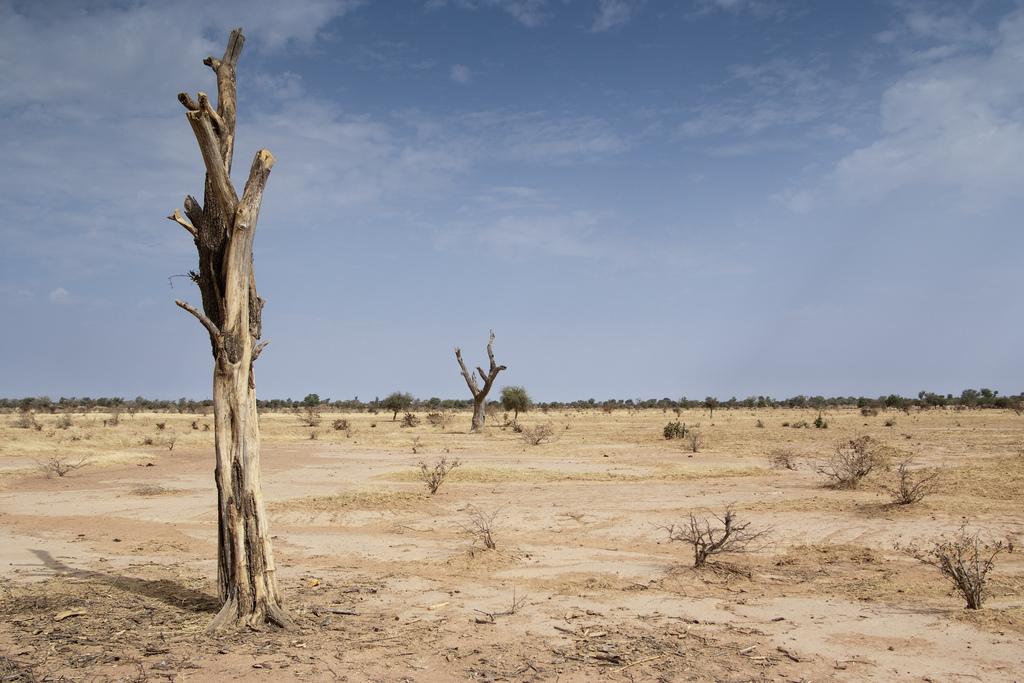Africa is the continent most affected by desertification, and one of the most obvious natural borders on the landmass is the Southern edge of the Sahara desert. The countries that lie on the edge of the Sahara are among the poorest in the world, and they are subject to periodic droughts that devastate its people. African dry-lands (which include the Sahara, the Kalahari, and the grasslands of East Africa) span 20 million square km (about 7.7 million square miles) which is some 65 per cent of the continent.
One-third of Africa’s dry-lands are largely uninhabited arid deserts, while the remaining two-thirds support two-thirds of the continent’s burgeoning human population. As Africa’s population increases, the productivity of the land supporting this population decline. Some one-fifth of the irrigated cropland, three-fifths of the rain-fed cropland, and three-fourths of the rangeland have been at least moderately harmed by desertification.
- Godfrey Utim: It was tough leaving seminary to play professional football
- ‘We need new constitution, amendments can’t solve our problems’
In general, desertification is caused by variations in climate and by unsustainable land-management practices in dry-land environments. By their very nature, arid and semiarid ecosystems are characterized by sparse or variable rainfall. Thus, climatic changes such as those that result in extended droughts can rapidly reduce the biological productivity of those ecosystems. Such changes may be temporary, lasting only a season or they may persist over many years and decades. On the other hand, plants and animals are quick to take advantage of wetter periods, and productivity can rapidly increase during these times.
Since dry-land environments are used for a variety of human purposes such as agriculture, animal grazing, and firewood collection, the various activities undertaken in them can exacerbate the problem of desertification and bring about lasting changes to dry-land ecosystems. In 1977, at the United Nations Conference on Desertification (UNCOD) in Nairobi, Kenya, representatives and delegates first contemplated the worldwide effects of desertification. The conference explored the causes and contributing factors and also possible local and regional solutions to the phenomenon.
In addition, the delegates considered the varied consequences of desertification, such as crop failures or decreased yields in rain-fed farmland, the loss of perennial plant cover and thus loss of forage for livestock, reduced woody biomass and thus scarcity of firewood and building materials, a decrease in potable water stocks from reductions in surface water and groundwater flow, increased sand dune intrusion onto croplands and settlements, increased flooding due to rising sedimentation in rivers and lakes, and amplified air and water pollution from dust and sedimentation.
The fourth area of desertification is dry woodlands, which are greatly affected by the over consumption of firewood. Across large areas of Asia and Africa, the principal raw material for cooking and heating is wood. Firewood in these areas is often converted to charcoal in earthen kilns before it is used, because charcoal gives off less smoke than wood. The conversion process is often inefficient, however, with about 75 percent of the wood’s heating potential lost. In Africa and Asia, a very rough estimate of the per capita consumption of firewood is about half a ton per year. Across large areas of dry-land where total plant production is roughly two tons per hectare per year, a family of four would have to clear a hectare of land or more per year. Very often, such deforested areas are not replanted. As human population densities increase, one can imagine that they might consume more wood than the land could support and create a “fuel-wood crisis.”
In a nutshell, the struggle against desertification can occur at several levels. Since regional variations in climate are the main causes of the loss of dryland productivity, it is important to understand the influence of global warming in specific dryland regions. According to some models of climate change, many types of grassland in western North America, for example, are predicted to be at greater risk of drought due to projected increases in summer temperatures and changes to existing rainfall patterns. Many authorities argue that since desertification and global warming are so closely related, one of the main solutions to the former may be the implementation of effective economic policies (such as carbon trading) and technical measures (such as carbon sequestration) that reduce the production of greenhouse gases.
On local scales, however, desertification is often the result of unsustainable land and soil management. To maintain the biological productivity of the land, soil conservation is often the priority. A number of innovative solutions have been devised that range from relatively simple changes in how people grow crops to labour-intensive landscape engineering projects. Some of the techniques that may help ameliorate the consequences of desertification in irrigated croplands, rain-fed croplands, grazing lands, and dry woodlands include; charcoal conversion improvements, dune stabilization, contour bunding, terracing, rotational grazing and irrigation improvements.
Mallam Musbahu Magayaki writes from Sabon Fegi, Azare, Bauchi State

 Join Daily Trust WhatsApp Community For Quick Access To News and Happenings Around You.
Join Daily Trust WhatsApp Community For Quick Access To News and Happenings Around You.



